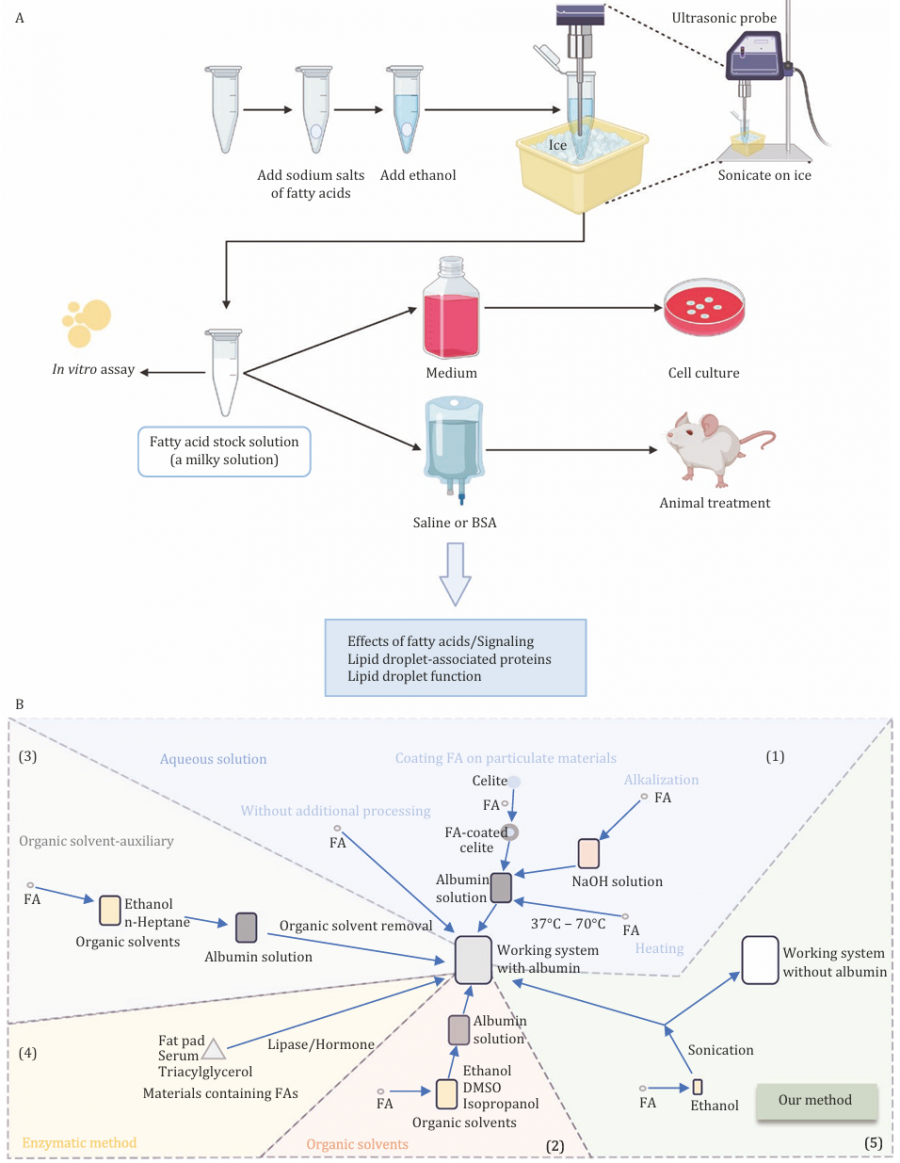
Breaking barriers: Novel fatty acid solution preparation improves cellular lipid research
GA, UNITED STATES, July 19, 2025 /EINPresswire.com/ -- Fatty acids (FAs) are pivotal to numerous cellular processes, from energy storage to signaling. However, their insolubility in water has long posed a challenge for researchers. A new method developed by researchers offers an efficient way to prepare stable, reproducible fatty acid stock solutions, enhancing the study of lipid droplets, metabolism, and metabolic diseases. This breakthrough avoids the need for albumin, ensuring precise, consistent fatty acid delivery. This technique promises to significantly advance research on lipid metabolism, offering a powerful tool for researchers studying the intricate roles of fatty acids in human health.
Fatty acids (FAs) are essential to cell membrane formation, energy storage, and lipid metabolism. Yet, delivering them for research remains a challenge due to their insolubility in water and the reliance on albumin to facilitate transport. While lipid droplets (LDs) have been shown to play an active role in maintaining energy balance within cells, current delivery techniques are often imprecise, introducing unwanted variables. As researchers continue to uncover the mechanisms behind metabolic diseases, a more controlled approach to fatty acid delivery is critical. To address these challenges, researchers sought a method that could provide reliable, albumin-free fatty acid solutions, enabling more accurate research into lipid metabolism and related disorders.
In a letter-style study published in Protein & Cell on December 17, 2024, a team of researchers from the Institute of Biophysics, Chinese Academy of Sciences, etc., has developed a new method for preparing fatty acid stock solutions. This novel technique uses sodium salts of fatty acids dissolved in ethanol, followed by sonication, to form stable micelles, enhancing the solubility and stability of fatty acids without the need for albumin. The resulting homogeneous milky solution is stable for up to six months, allowing for precise fatty acid delivery in both in vitro and in vivo studies. This method could become an essential tool for researchers investigating lipid metabolism and related diseases, opening up new avenues for therapeutic development.
This new method for preparing fatty acid solutions stands out for its simplicity and precision. By using sodium salts of fatty acids, such as oleic acid (OA) and palmitic acid (PA), dissolved in ethanol and sonicated, the researchers have devised a process that ensures the delivery of fatty acids in a stable, homogeneous micellar form. Unlike traditional methods that require albumin to transport fatty acids, this new approach eliminates the need for albumin entirely, preventing any potential interference. Sonication is used to enhance fatty acid solubility and micelle formation, yielding a solution that remains stable even when stored for extended periods. The technique has been proven effective in a range of studies, from investigating the distinct effects of saturated versus unsaturated fatty acids on lipid droplet dynamics and exploring their role in metabolic diseases like insulin resistance, to enabling the identification of novel lipid droplet-associated proteins (LDANPs) and developing novel assays to study lipid synthesis directly on isolated lipid droplets. This method allows for precise control over fatty acid concentrations, enabling reproducible results across different experiments and laboratories. Moreover, the approach is versatile, supporting the study of various fatty acids, including polyunsaturated types, making it a valuable resource for diverse research fields. Researchers have already used the solution to study lipid droplets' size, distribution, and impact on cellular processes, providing new insights into their role in health and diseases.
Dr. Shuyan Zhang, one of the first authors as well as corresponding authors of the study, explains: This method advances how researchers study fatty acids and their role in lipid metabolism. By eliminating the need for albumin using sodium salts of fatty acids dissolved in ethanol with sonication to form stable micelles, more precise and reproducible results can be achieved, which is crucial for understanding the complex dynamics of lipid droplets and their involvement in metabolic diseases. This innovation will undoubtedly support a wide range of studies, from investigating the fundamental biology of lipids to developing new treatments for conditions like obesity, diabetes, and cardiovascular disease.
The implications of this new fatty acid preparation method extend far beyond the laboratory. By providing a reliable, albumin-free system for fatty acid delivery, this approach is poised to accelerate research on lipid metabolism and related diseases, such as obesity, diabetes, and cardiovascular conditions. The method allows researchers to study the role of lipid droplets in these diseases with greater precision, potentially leading to new therapeutic strategies. Moreover, its flexibility to handle various types of fatty acids opens doors for studies comparing the effects of different lipid profiles, thus advancing our understanding of how lipids influence cellular functions and overall health.
References
DOI
10.1093/procel/pwae068
Original Source URL
https://doi.org/10.1093/procel/pwae068
Funding information
This work was supported by the National Key R&D Program of China (Grant Nos. 2023YFA1801103, 2018YFA0800700, and 2018YFA0800900) and National Natural Science Foundation of China (Grant Nos. 92357302, 32170787, 91954108, and 32100557).
Lucy Wang
BioDesign Research
email us here
Distribution channels: Science, Technology
Legal Disclaimer:
EIN Presswire provides this news content "as is" without warranty of any kind. We do not accept any responsibility or liability for the accuracy, content, images, videos, licenses, completeness, legality, or reliability of the information contained in this article. If you have any complaints or copyright issues related to this article, kindly contact the author above.
Submit your press release
